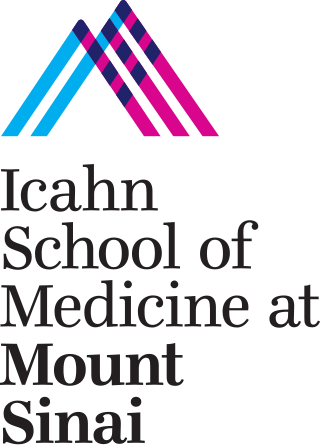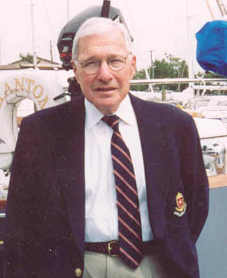Related Research Articles

Paul Dudley White was an American physician and cardiologist. He was considered one of the leading cardiologists of his day, and a prominent advocate of preventive medicine.

The Icahn School of Medicine at Mount Sinai, formerly the Mount Sinai School of Medicine, is a private medical school in New York City, New York, United States. The school is the academic teaching arm of the Mount Sinai Health System, which manages eight hospital campuses in the New York metropolitan area, including Mount Sinai Hospital and the New York Eye and Ear Infirmary.
Frans Jozef Thomas Wackers is a Dutch American clinical cardiologist and research scientist known for his contributions to nuclear cardiology. In 1974, he explored a new way of visualizing heart disease. He pioneered using the radioisotope thallium-201 for heart imaging, which started a new cardiology sub-specialty, later called Nuclear Cardiology. Wackers was the director of the Cardiovascular Nuclear Imaging and Stress Laboratories at Yale School of Medicine for 22 years. In 2008, he became a Professor Emeritus at Yale University. On January 1, 2013, Wackers fully retired from clinical and scientific responsibilities.
Eugene Braunwald is an Austrian-born American cardiologist.

Bernard Lown was a Lithuanian-American cardiologist and inventor. Lown was the original developer of the direct current defibrillator for cardiac resuscitation, and the cardioverter for correcting rapid disordered heart rhythms. He introduced a new use for the drug lidocaine to control heartbeat disturbances.
Paul N. Yu was an American cardiologist, physician-scientist and educator of Chinese descent, and a product of Chinese, British and American medical education. Over a career spanning several decades he trained numerous individuals in clinical cardiology who went on to leadership positions in academia throughout this country.

Valentín Fuster Carulla, 1st Marquess of Fuster is a Spanish cardiologist and aristocrat.
Nicholas George Kounis is professor emeritus of cardiology in the University of Patras and scientific cardiology advisor at Saint Andrews State General Hospital Patras and at the Department of cardiology of University of Patras Medical School, Patras, Greece.
Peter John Hurley was a New Zealand doctor. He was the first full-time physician in nuclear medicine at Auckland Hospital in 1972 and he established the Department of Nuclear Medicine there between 1971 and 1982. He "was one of the most gifted young physicians of his generation".
Professor Peter Sleight M.D.(Cantab.), D.M. (Oxon.) FRCP FACC was a distinguished and internationally renowned research cardiologist and an Honorary Consultant Physician at the John Radcliffe Hospital in Oxford and the Oxford University Hospitals NHS Foundation Trust. Sleight was Emeritus Field Marshal Alexander Professor of Cardiovascular Medicine at the University of Oxford and an Emeritus Fellow of Exeter College, Oxford.

James S. Forrester III is an American cardiologist. Born in Philadelphia, Pennsylvania, he received his medical training at the University of Pennsylvania, UCLA, and Harvard University. During the 1970s through 1990s, his research led to three major advancements in the practice of cardiology. Later in his career, he would return to UCLA, this time as a professor, while simultaneously being the Chief of the Division of Cardiology at Cedars-Sinai Medical Center. Forrester has published hundreds of papers and manuscripts dealing with the subject of cardiology, and is the recipient of numerous awards, including being the second person to ever receive the Lifetime Achievement Award of the American College of Cardiology in 2009.

Edmund Hiram Sonnenblick was an American medical researcher and cardiologist. His studies of the function of cardiac muscle cells during the 1960s shaped the basis of both cardiovascular physiology and the modern treatment of cardiovascular disease, making possible the development of ACE inhibitors. In 1962, he was credited as the first person to image the heart muscle under scientifically-controlled conditions using the electron microscope. Though Sonnenblick's ideas about the relationship between the structure and function of the human heart today constitute medical-scientific commonsense, they were utterly novel at the time.
Ola (Olakunle) Akinboboye is a Nigerian-American nuclear cardiologist.
Donald S. Baim was a researcher and clinician in the field of interventional cardiology. Baim's primary research focused on coronary blood flow, catheter intervention in heart disease, and congestive heart failure. His work helped to shift the use of catheters from a purely diagnostic tool to a therapeutic tool. After receiving a medical degree from Yale and initial medical training, residency and a fellowship at Stanford University Medical Center, Baim spent the bulk of his career at Beth Israel Hospital and at the Brigham and Women's Hospital in Boston. In 1993, Baim founded the Beth Israel Hospital's Cardiovascular Data Analysis Center (CDAC) -- later to be named Harvard Clinical Research Institute (HCRI). Baim died of cancer in November 2009. In October 2016, HCRI changed its name to the Baim Institute for Clinical Research.
Arthur Jay Moss was an American cardiologist.
Attilio Maseri OMRI KSG was an Italian academic and physician specialized in cardiology, considered a leading researcher in the field of ischemic heart disease. His patients included Queen Elizabeth II and Pope John Paul II.

Lee Goldman is an American cardiologist and educator at Columbia University, where he is professor of medicine at the Vagelos College of Physicians and Surgeons, professor of epidemiology at the Mailman School of Public Health, and dean emeritus of the Faculties of Health Sciences and Medicine. From 2006 to 2020 he served as executive vice president and dean of the Faculties of Health Sciences and Medicine, chief executive officer of the Columbia University Irving Medical Center, and Harold and Margaret Hatch Professor of the university. Before moving to Columbia, he was chair of the department of medicine at the University of California, San Francisco. He received his B.A., M.D., and M.P.H. degrees from Yale University.

Jason C. Kovacic is an Australian-born cardiologist and physician-scientist; the Robert Graham Chair and Professor of Medicine, University of New South Wales; Executive Director of the Victor Chang Cardiac Research Institute in Sydney, Australia; and Professor of Medicine (Cardiology) at the Icahn School of Medicine at Mount Sinai, New York.
Ariel David Soffer is an American cardiologist and professor. He is board-certified in cardiovascular disease and internal medicine and is a fellow of the American College of Cardiology.
Robert I. Levy (1937–2000) was an American physician and pioneer of preventive cardiology best known for his research that established the link between low-density lipoprotein cholesterol and heart disease.
References
- ↑ "Dr. Barry L. Zaret Tribute". American Society of Nuclear Cardiology.
- 1 2 In Memoriam: Barry L. Zaret, MD, MASNC Journal of Nuclear Cardiology, December 2022. Retrieved 22 March 2024.
- ↑ New York University School of Medicine
- 1 2 3 4 5 History Corner: Barry L. Zaret, MD and H. William Strauss, MD, Journal of Nuclear Cardiology, September/October 2019. Retrieved 22 March 2024.
- 1 2 3 4 5 Leppo, Jeffrey; Strauss, H. William; Narula, Jagat (2023). "In Memoriam: Barry Zaret—A Life Well Lived, A Guiding Beacon, A Paragon to Follow". Journal of the American College of Cardiology. 81 (4): 425–427. doi: 10.1016/j.jacc.2022.12.009 . PMID 36697142.
- 1 2 Barry L. Zaret: Physician, Poet, Author and Painter . Retrieved 22 March 2024.
- ↑ Lehenbauer, Kyle (2021) Leading by example: Experiences and lessons learned from ASNC’s Future Leaders of Nuclear Cardiology Symposium, Journal of Nuclear Cardiology, May/June 2021. Retrieved 22 March 2024
- ↑ "In Memoriam: Barry L. Zaret, MD". Yale School of Medicine. 24 October 2022. Retrieved 22 March 2024.
- ↑ Mongkol, Chatwan. "Family mourns death of Yale doctor, professor Barry Zaret". New Haven Register.